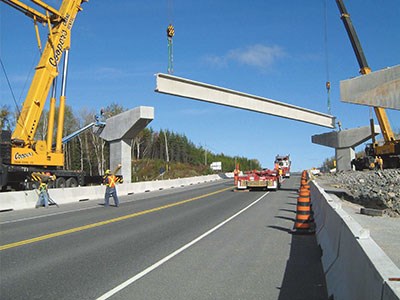Spanning decades, and costing billions, the four-laning of Highways 11 and 69 (now Highway 400) is anticipated to provide Northern Ontario with an unprecedented level of connectivity that will increase its access to new markets and open up the North to economic diversity.
Planning for the expansion of Highway 11 between North Bay and Huntsville began in 1979 and since then, the province has invested $1 billion to four-lane what’s considered a strategic gateway to Northern Ontario, said Gordan Rennie, regional issues and media advisor for the Ministry of Transportation’s northeastern region.
“Highway 11 is a key gateway to North Bay and Northern Ontario and a nationally significant highway route,” Rennie said in an email. “Ontario's investment in the four-laning of Highway 11 makes travel easier and safer for families and businesses and will strengthen tourism and the Northern economy.” Projects followed in 1983, 1985, 1987, 1991, and 1993 to extend the four-laning 27 kilometres south of North Bay to Powassan, Rennie said. Construction on the final 93 kilometres, from Powassan to Huntsville began in 1995 and was continuous until the corridor was completed in summer 2012.
Average daily traffic volumes between Huntsville, and North Bay are 9,300, including 1,200 commercial vehicles, Rennie said. In the summer, average daily volumes grow to 11,400.
It took a huge amount of work and aggregate to complete the infrastructure.
“Between Powassan and Huntsville, construction included 16 new interchanges, 54 new bridges, 1.7 million cubic metres of rock excavation, 10.5 million cubic metres of earth excavation, 4.6 million tonnes of granular material and 500,000 tonnes of asphalt,” Rennie said.
Though it’s not tracking data on the number of travellers coming through the city, North Bay is noticing an impact following the completion of the newly installed corridor, said Erin Richmond, the city’s manager of economic development.
“Overall, it’s definitely going to support our transportation network and our ability to get people to North Bay quicker, faster,” she said.
Because “North” is included in the city’s name, southerners think the city is farther than it is, or regularly get it mixed up with Thunder Bay, Richmond said.
But now, when delegates are in southern Ontario drumming up interest in development opportunities in North Bay, southerners are surprised at the close proximity to Toronto.
“When I say it took me three, three and a half hours to get down where I am, people are very surprised by that,” she said. “So the idea of people being easily able to connect with us is definitely an asset.”
The most noticeable shift has been in the film industry, as more filmmakers are using North Bay, along with Sudbury and Sault Ste. Marie, as shooting locations.
Still in construction, the first planning for the four-laning of Highway 69 (400), between Parry Sound to north of Nobel, has been underway since 1990, followed by the section from Sudbury to French River in 1994, Rennie said.
Planning for work between Sudbury and Parry Sound began in 2003, while construction began in 2005 and has been continuous since. The project has been broken into five increments to facilitate federal environmental approvals.
“The four-laning of Highway 69 has been the most ambitious expansion project in the history of Northern Ontario,” Rennie said, who noted that “the route has been planned to minimize impacts while passing through rugged Northern geography of rock, swamp, lakes and rivers.”
The route includes a wildlife bridge and tunnels to keep large animals off the roadway, reducing animal-vehicle collisions.
Part of the Canadian National Railway route also has to be rejigged to allow for the construction of the interchange at Highway 522, Rennie said.
This highway’s construction, too, will require crews to move massive amounts of material before it’s complete.
“Overall, four-laning from Sudbury to Parry Sound will involve 23 million cubic metres of rock excavation, or 2.3 million truck loads,” Rennie said. “Construction of the highway will also involve seven million cubic metres of earth excavation, eight million tonnes of granular material and 1.3 million tonnes of asphalt. The majority of raw materials, such as granular material and earth fill, will come directly from sources within the right-ofway during construction.”
To date, 50 kilometres between Parry Sound and Sudbury have been finished. Another 20 kilometres of four-laning began last summer, after which only 82 kilometres remain to complete the four-laning from Sudbury to Toronto, Rennie said. When complete, the total investment to four-lane Highway 69 between Port Severn and Sudbury will exceed $2.4 billion.




